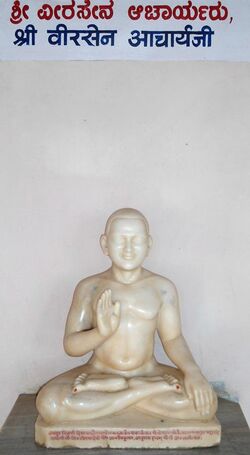Biography:Virasena
Acharya Shri Virasena Ji Maharaj | |
|---|---|
 Acharya Virasena | |
| Personal | |
| Born | 792 CE |
| Religion | Jainism |
| Sect | Digambara |
| Notable work(s) | Dhavala |
| Religious career | |
| Predecessor | Aryanandi |
| Successor | Jinasena |
Acharya Virasena (792-853 CE),[1] also known as Veerasena, was a Digambara monk and belonged to the lineage of Acharya Kundakunda.[2] He was an Indian mathematician and Jain philosopher and scholar. He was also known as a famous orator and an accomplished poet.[3] His most reputed work is the Jain treatise Dhavala.[4] The late Dr. Hiralal Jain places the completion of this treatise in 816 AD.[5]
Virasena was a noted mathematician. He gave the derivation of the volume of a frustum by a sort of infinite procedure. He worked with the concept of Ardha Chheda: the number of times a number could be divided by 2; effectively base-2 logarithms. He also worked with logarithms in base 3 (trakacheda) and base 4 (caturthacheda).[6]
Virasena gave the approximate formula C = 3d + (16d+16)/113 to relate the circumference of a circle, C, to its diameter, d. For large values of d, this gives the approximation π ≈ 355/113 = 3.14159292..., which is more accurate than the approximation π ≈ 3.1416 given by Aryabhata in the Aryabhatiya.[7]
Life
Virasena was proficient in astrology, grammar, logic, mathematics and prosody. He wrote Dhavala, a commentary on Jain canon Shatakhandagama. He also started the work on Jayadhavalaa which was competed by his disciples. He was among the jewels of Rashtrakuta king Amoghavarsha.[8]
His lineage started with Chandrasena who initiated Aryanandi.[9] Aryanandi initiated Virasena and Jayasena.[9] Virasena initiated six disciples who were Dasharayguru, Jinasena, Vinayasena, Shripal, Padmasena and Devasena.[9] Dasharayguru and Jinasena initiated Gunabhadra who later initiated Lokasena.[9] Vinayasena initiated Kumarasena who started the Kashtha Sangha.[9]
See also
- Indian mathematics
- Umaswami
References
Citations
- ↑ Jaini 1991, p. 111.
- ↑ Indranandi. Shrutāvatāra
- ↑ Jinasena. Ādi Purāņa
- ↑ Satkhandagama : Dhavala (Jivasthana) Satparupana-I (Enunciation of Existence-I) An English Translation of Part 1 of the Dhavala Commentary on the Satkhandagama of Acarya Pushpadanta & Bhutabali Dhavala commentary by Acarya Virasena English tr. by Prof. Nandlal Jain, Ed. by Prof. Ashok Jain ISBN:9788186957479
- ↑ Nagrajji, Acharya Shri (2003). Agama and Tripitaka: Language and Literature. Concept Publishing Company. p. 530. ISBN 9788170227311.
- ↑ Gupta, R. C. (2000), "History of Mathematics in India", in Hoiberg, Dale; Ramchandani, Indu (in en), Students' Britannica India: Select essays, Popular Prakashan, p. 329, https://books.google.com/books?id=-xzljvnQ1vAC&q=Virasena+logarithm&pg=PA329
- ↑ Mishra, V.; Singh, S. L. (February 1997), "First Degree Indeterminate Analysis in Ancient India and its Application by Virasena", Indian Journal of History of Science 32 (2): 127–133, http://www.new1.dli.ernet.in/data1/upload/insa/INSA_1/20005b5d_127.pdf
- ↑ Natubhai Shah 2004, p. 31.
- ↑ 9.0 9.1 9.2 9.3 9.4 Pannalal Jain 1951, pp. 30-31.
Sources
- Jain, Pannalal, ed. (1951), Mahapurana Adipurana of Bhagavata Jinasenacharya, Bharatiya Jnanapitha, https://archive.org/details/in.ernet.dli.2015.327048
- Jaini, Padmanabh S. (1991), Gender and Salvation: Jaina Debates on the Spiritual Liberation of Women, University of California Press, ISBN 0-520-06820-3, https://books.google.com/books?id=GRA-uoUFz3MC
- Shah, Natubhai (2004), Jainism: The World of Conquerors, I, Motilal Banarsidass, ISBN 81-208-1938-1, https://books.google.com/books?id=qLNQKGcDIhsC
External links
- Singh, A. N.. "Mathematics of Dhavala". http://www.jainworld.com/JWHindi/Books/shatkhandagama-4/02.htm. Translation of part of the Dhavala.
